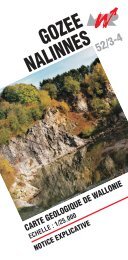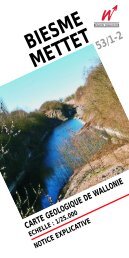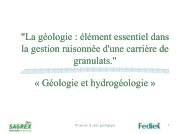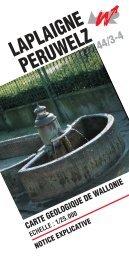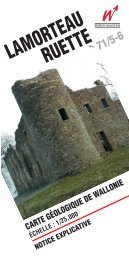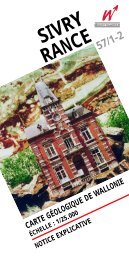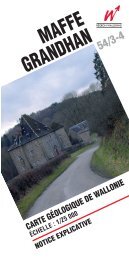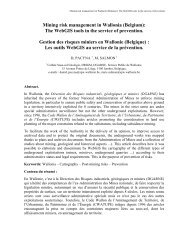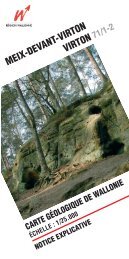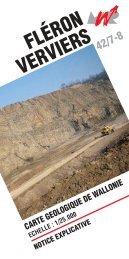Télécharger le fichier - Service géologique de Wallonie
Télécharger le fichier - Service géologique de Wallonie
Télécharger le fichier - Service géologique de Wallonie
Create successful ePaper yourself
Turn your PDF publications into a flip-book with our unique Google optimized e-Paper software.
Fig. 41 : Classification <strong>de</strong>s houil<strong>le</strong>s suivant <strong>le</strong>ur teneur en matièrevolati<strong>le</strong> dans <strong>le</strong>s différentes parties du Bassin houil<strong>le</strong>r <strong>de</strong>Char<strong>le</strong>roi.La qualité <strong>de</strong>s charbons n’est pas uniforme dans <strong>le</strong> bassin<strong>de</strong> Char<strong>le</strong>roi. En règ<strong>le</strong> généra<strong>le</strong>, la teneur en matières volati<strong>le</strong>sdiminue à mesure que l’on s’enfonce dans <strong>le</strong> gisement (règ<strong>le</strong> <strong>de</strong>Hilt). A Char<strong>le</strong>roi, la teneur en matière volati<strong>le</strong> s’accroît du nordau sud, en passant d’un massif à l’autre: <strong>le</strong>s massifs charriésfournissent <strong>de</strong>s houil<strong>le</strong>s grasses, <strong>le</strong>s massifs sous-jacents, <strong>de</strong>scharbons plus maigres (fig. 41).De nettes variations sont aussi mesurées d’est en ouest ausein d’une même unité tectonique. Le Comb<strong>le</strong> Nord livre <strong>de</strong>shouil<strong>le</strong>s maigres voire anthraciteuses, à l’est <strong>de</strong> la planchette.El<strong>le</strong>s y sont plus grasses dans la région <strong>de</strong> Trazegnies - Courcel<strong>le</strong>s(Bascoup, puits 5 et 6, gisement <strong>de</strong> Courcel<strong>le</strong>s-N, du Nord<strong>de</strong> Char<strong>le</strong>roi sous la Fail<strong>le</strong> du Centre).Le Massif du Centre et <strong>le</strong>s massifs imbriqués contiennent<strong>de</strong>s charbons maigres à mi-gras (8 à 15% M.V.), dont la teneur enmatières volati<strong>le</strong>s tend à s’accroître vers <strong>le</strong> sud. Les massifs supérieursse distinguent par <strong>de</strong>s houil<strong>le</strong>s grasses, riches en matièresvolati<strong>le</strong>s (<strong>de</strong> 17 à plus <strong>de</strong> 30%). Plusieurs étu<strong>de</strong>s détaillées <strong>de</strong>svariations qualitatives <strong>de</strong>s charbons ont été proposées jusqu’ici(Delmer 1920, Legraye 1944). El<strong>le</strong>s indiquent un net changement<strong>de</strong>s teneurs en matières volati<strong>le</strong>s à hauteur <strong>de</strong> la fail<strong>le</strong> qui sépare <strong>le</strong>Massif charrié à houil<strong>le</strong>s grasses (Tombe-Ormont-Chamborgneau)<strong>de</strong>s massifs sous-jacents (Massifs du Centre et ses divisions).4.2. La pierre calcairea. Concassés et produits cuitsLa pierre calcaire est exploitée intensément dans <strong>le</strong>s vallées<strong>de</strong> la Sambre et <strong>de</strong> l’Eau d’Heure. Trois gran<strong>de</strong>s carrièressont encore en activité :- <strong>le</strong>s Calcaires <strong>de</strong> la Sambre exploitent la Formation <strong>de</strong> Neffeet fournissent un calcaire blanc très pur aux industries <strong>de</strong> lasucrerie et du verre, ainsi qu’à la sidérurgie;72



